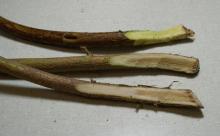Cause The fungus, Fusarium sambucinum (teleomorph: Gibberella pulicaris), survives in soil and diseased plants and has been found in OR, WA, and ID. Confirmed by OSU in 'Chinook', 'Fuggles', 'Galena', 'Glacier', 'Mt. Hood', 'Nugget', 'Sterling', 'Willamette', and 'Zeus' varieties in the Pacific Northwest. The incidence of hop canker in the field is sporadic, not every bine on a hill is affected. Field observations have suggested that the onset of disease appears to be more severe under wet conditions, including growing seasons following flooding during wet winters. Hops grown in areas where the water table is high or where there is poor drainage had higher levels of canker. Higher rainfall may lead to increased soil moisture and in seasons where increased rainfall has occurred there have been more severe outbreaks of this disease. Fields with high levels of Hop stunt viroid also have been observed to have very high incidences of Fusarium canker and the presence of canker may lead to the discovery of the viroid disease in varieties more tolerant of Hop stunt viroid infections.
Symptoms The affected bine wilts rapidly and suddenly; often at flowering or during hot weather. It is detached or can be detached readily from the crown with a gentle tug. The point of bine attachment to the crown usually is tapered or rounded off so that only a few central vascular elements connect the bine to the crown. Mechanical agitation (wind, tractors, sprayers, etc.) frequently break the connection; symptoms sometimes are attributed to "tractor blight." If the bine remains connected until late in the season, it possibly will collapse in hot weather. The bine's base may be swollen because carbohydrate movement has been inhibited; sometimes affected stems have a longitudinal split in the colonized cortical area of the bine. Vascular discoloration does not seem to be associated with the disease. Cankers can be found on rhizomes of affected plants. Wilted bines could potentially be confused with wilt caused by Verticillium species. The pattern of necrosis on leaves and vascular discoloration associated with Verticillium infection differentiates Verticillium wilt from canker.
Cultural control Specific control measures have not been researched; however, field observations indicate the following may help.
- Avoid injury to hop plants.
- Reduce crown wetness by hilling higher relative to rill irrigation ditches, by removing sucker growth that could shade the crown, and by reducing mulch.
- Lime to increase soil pH above 7. Maintain the higher pH by using less ammonium-based nitrogen fertilizer; use nitrate-based fertilizer instead.
Biological control Efficacy of these products on this disease in the PNW is unknown.
- Asperello at 1.5 to 10.7 oz/A on 7- to 10-day intervals as a foliar spray or at 0.1 to 0.7 oz/100 gal water on 8- to 12-week intervals for chemigation at 2,000 to 5,000 gal/A. 12-hr reentry. O
- Bio-Tam 2 at 2.5 to 3 lb/A as a banded ground spray or at 2.5 to 5 lb/A on 14- to 21-day intervals for chemigation. 4-hr reentry. O
- Bexfond at 7 to 14 fl oz/A for soil applications via drenches, in-furrow applications, drip irrigation, or sprays, followed by irrigation, reapply on 4-week intervals. 4-hr reentry. O
- Theia at 1 to 5 lb/A for soil applications via drenches, in-furrow applications, drip irrigation, or sprays, followed by irrigation. Preharvest interval is 0 days. 4-hr reentry. O




